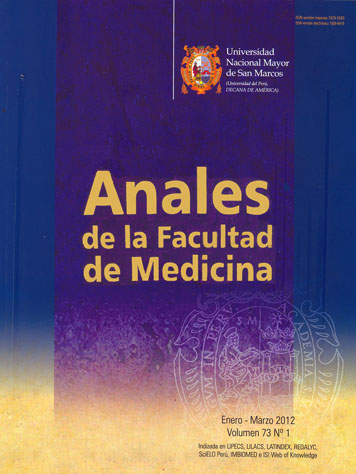Standarization of an ELISA test to detect IgE antibodies in patients with cystic echinococcosis and its use in diagnosis and follow-up of patients treated with albendazol: preliminary report
DOI:
https://doi.org/10.15381/anales.v73i1.808Keywords:
IgE ELISA, cystic echinococcosis, albendazole.Abstract
Objectives: To determine best dilutions and concentrations of ELISA test to detect IgE antibody, its sensitivity and specificityand predictive value in patients with cistyc echinococcosis. To analyze the relationship between IgE specific antibody level andalbendazole medical treatment response in a period over one year after completion of albendazole therapy. Design: Quasiexperimentalstudy with control group. Setting: Instituto de Medicina Tropical Daniel A. Carrion, Faculty of Medicine, UNMSM,Lima, Peru. Study material: IgE antibody ELISA test. Interventions: IgE antibody ELISA test standardization with preexperimentalpretest and post test in one group to assess its value in diagnosis and post-treatment of patients with hepatic hydatid cysts treatedwith albendazole. For ELISA test standardization we used serum from five patients with clinical and immunological diagnosis ofcystic echinococcosis; to test sensitivity and specificity sera of 30 apparently healthy subjects were studied; to determine crossreactions16 serum samples from patients with other helminth infections (ascariasis, strongiloidiasis, toxocariasis, trichuriasis,hymenolepiasis cysticercosis and taeniasis) were used. For diagnosis and post-treatment evaluation of cystic echinocococosisserum from 17 patients was studied. Main outcome measures: Standarized ELISA test sensitivity and specificity to detect IgEantibodies. Results: Sensitivity and specificity of standardized ELISA test to detect IgE antibody were respectively 95.6% and 100%.Patients with hepatic hydatid cyst considered cured uniformly showed lower levels of IgE antibody even to negativization. There wasincrease of IgE levels in patients who had recurrence of hepatic cystic disease. Conclusions: This study found excellent sensitivity andspecificity of ELISA test for cystic echinococcosis IgE antibodies. Healing of cysts coincided with progressive decrease in IgE levelsthat could reach negativization after one year post-treatment and was useful to detect recurrence. Persistence of IgE high levels inpatients treated medically was indicative of no response to treatment. As sample size was not large, it seems necessary to continueinvestigation to confirm these results.Downloads
Published
2012-03-19
Issue
Section
Sección especial de Medicina Tropical
License
Copyright (c) 2012 Herman Vildózola, Irma Espinoza, William H. Roldan

This work is licensed under a Creative Commons Attribution-NonCommercial-ShareAlike 4.0 International License.
Those authors who have publications with this magazine accept the following terms:
- Authors will retain their copyrights and guarantee the journal the right of first publication of their work, which will be simultaneously subject to Creative Commons Attribution License that allows third parties to share the work as long as its author and its first publication this magazine are indicated.
- Authors may adopt other non-exclusive licensing agreements for the distribution of the version of the published work (eg, deposit it in an institutional electronic file or publish it in a monographic volume) provided that the initial publication in this magazine is indicated.
- Authors are allowed and recommended to disseminate their work over the Internet (eg: in institutional telematic archives or on their website) before and during the submission process, which It can produce interesting exchanges and increase quotes from the published work. (See El efecto del acceso abierto ).
How to Cite
1.
Vildózola H, Espinoza I, Roldan WH. Standarization of an ELISA test to detect IgE antibodies in patients with cystic echinococcosis and its use in diagnosis and follow-up of patients treated with albendazol: preliminary report. An Fac med [Internet]. 2012 Mar. 19 [cited 2025 Jun. 5];73(1):35-41. Available from: https://revistasinvestigacion.unmsm.edu.pe/index.php/anales/article/view/808



